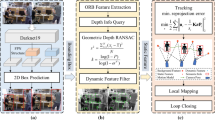Abstract
AR (Augmented reality) is a research hotspot in the current computer application field. AR technology enhances people’s understanding and experience of the real environment by adding virtual objects to real scenes to integrate virtual objects with the real environment. Aiming at the weak processing power of intelligent terminals and the characteristics of limited hardware resources, this paper proposes a more effective human motion feature extraction and descriptor algorithm. The feature point detection and positioning method suitable for intelligent terminals is proposed in a targeted manner, which solves the problem of mismatching of similar structures. In addition, this paper proposes an AR-oriented recursive tracking algorithm for human motion. The positional relationship of the current frame is calculated from the position of the previous frame. A combination of ORB (Oriented fast and Rotated Brief) feature descriptors and KLT (Kanade-Lucas-Tomasi) algorithm is adopted. The ORB feature descriptor matched by the first frame image and the reference image is tracked by the KLT tracking algorithm, and the feature descriptor of the previous frame is tracked in the current frame, thereby eliminating the phenomenon of virtual object jitter. The experimental results show that the recursive tracking scheme has better performance in time and precision than the detection tracking scheme.











Similar content being viewed by others
References
Terander, A.E., Nachabe, R., Skulason, H.: Feasibility and accuracy of thoracolumbar minimally invasive pedicle screw placement with augmented reality navigation technology. Spine 43(14), 1 (2017)
MacDougall, R.D., Scherrer, B., Don, S.: Development of a tool to aid the radiologic technologist using augmented reality and computer vision. Pediatr. Radiol. 48(1), 141–145 (2017)
Rojas-Muñoz, E., Cabrera, M.E., Andersen, D.: Surgical telementoring without encumbrance: a comparative study of see-through augmented reality-based approaches. Ann. Surg. 270(2), 1 (2018)
Marroquin, R., Lalande, A., Hussain, R., et al.: Augmented reality of the middle ear combining otoendoscopy and temporal bone computed tomography. Otol. Neurotol. 39(8), 931–939 (2018)
Lin, S., Cheng, H.F., Li, W.: Ubii: physical world interaction through augmented reality. IEEE Trans. Mobile Comput. 16(3), 1–1 (2016)
Quercioli, F.: Beyond laser safety glasses: augmented reality in optics laboratories. Appl. Opt. 56(4), 1148 (2017)
Santos, O.C.: Artificial intelligence in psychomotor learning: modeling human motion from inertial sensor data. Int. J. Artif. Intell. Tools. 28(4), 1940006 (2019)
Lee, Y.-H., Yin, K., Shin-Tson, Wu.: Reflective polarization volume gratings for high efficiency waveguide-coupling augmented reality displays. Opt. Express 25(22), 27008 (2017)
Jiang, T., Zhu, M., Zan, T.: A novel augmented reality-based navigation system in perforator flap transplantation—a feasibility study. Ann. Plast. Surg. 79(2), 192–196 (2017)
Lamberti, F., Manuri, F., Paravati, G.: Using semantics to automatically generate speech interfaces for wearable virtual and augmented reality applications. IEEE Trans. Human-Machine Syst. 47(1), 1–13 (2016)
Ferrari, V., Cutolo, F.: Letter to the editor: augmented reality–guided neurosurgery. J. Neurosurg. 125(1), 1–2 (2016)
He, G.Q., Liu, G.Y., Xu, W.M.: p57KIP2-mediated inhibition of human trophoblast apoptosis and promotion of invasion in vitro. Int. J. Mol. Med. 44(1), 281 (2019)
Zhu, R., Tan, G., Yuan, J.: Functional reflective polarizer for augmented reality and color vision deficiency. Opt. Express 24(5), 5431 (2016)
Lee, S., Jang, C., Moon, S.: Additive light field displays: realization of augmented reality with holographic optical elements. Acm Trans. Graph. 35(4), 1–13 (2016)
Robinson, P.W.: Implementation of an augmented reality interface to reproduce and compare soundscapes. J. Acoust. Soc. Am. 138(3), 1750–1750 (2015)
Chen, H.-S., Wang, Y.-J., Chen, P.-J.: Electrically adjustable location of a projected image in augmented reality via a liquid-crystal lens. Opt. Express 23(22), 28154 (2015)
Lee, A., Lee, J.-H., Kim, J.: Data-driven kinematic control for robotic spatial augmented reality system with loose kinematic specifications. Etri J. 38(2), 337–346 (2016)
Kim, G., Kim, D., Park, S.: An augmented reality processor with a congestion-aware network-on-chip scheduler. IEEE Micro 34(6), 31–41 (2014)
Chen, M., Lu, S., Liu, Q.: Uniform regularity for a Keller-Segel-Navier-Stokes system. Appl. Math. Lett. 107, 106476 (2020)
Hong, K., Yeom, J., Jang, C.: Full-color lens-array holographic optical element for three-dimensional optical see-through augmented reality. Opt. Lett. 39(1), 127–130 (2014)
Gurbuz, S.Z., Amin, M.G.: Radar-based human-motion recognition with deep learning: promising applications for indoor monitoring. IEEE Signal Proc. Magazine 36(4), 16–28 (2019)
Sun, X., Liu, Y., Wei, W., et al.: Based on QoS and energy efficiency virtual machines consolidation techniques in Cloud[J]. J. Internet Technol. 20(6), 1849–1859 (2019)
Zhang, L., Xu, Q., Zhu, G., et al.: Improved colour-to-grey method using image segmentation and colour difference model for colour vision deficiency[J]. IET Image Proc. 12(3), 314–319 (2017)
Author information
Authors and Affiliations
Corresponding author
Additional information
Publisher's Note
Springer Nature remains neutral with regard to jurisdictional claims in published maps and institutional affiliations.
Rights and permissions
About this article
Cite this article
Yue, S. Human motion tracking and positioning for augmented reality. J Real-Time Image Proc 18, 357–368 (2021). https://doi.org/10.1007/s11554-020-01030-6
Received:
Accepted:
Published:
Issue Date:
DOI: https://doi.org/10.1007/s11554-020-01030-6




